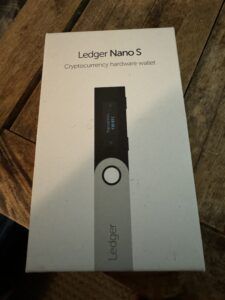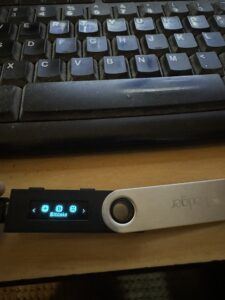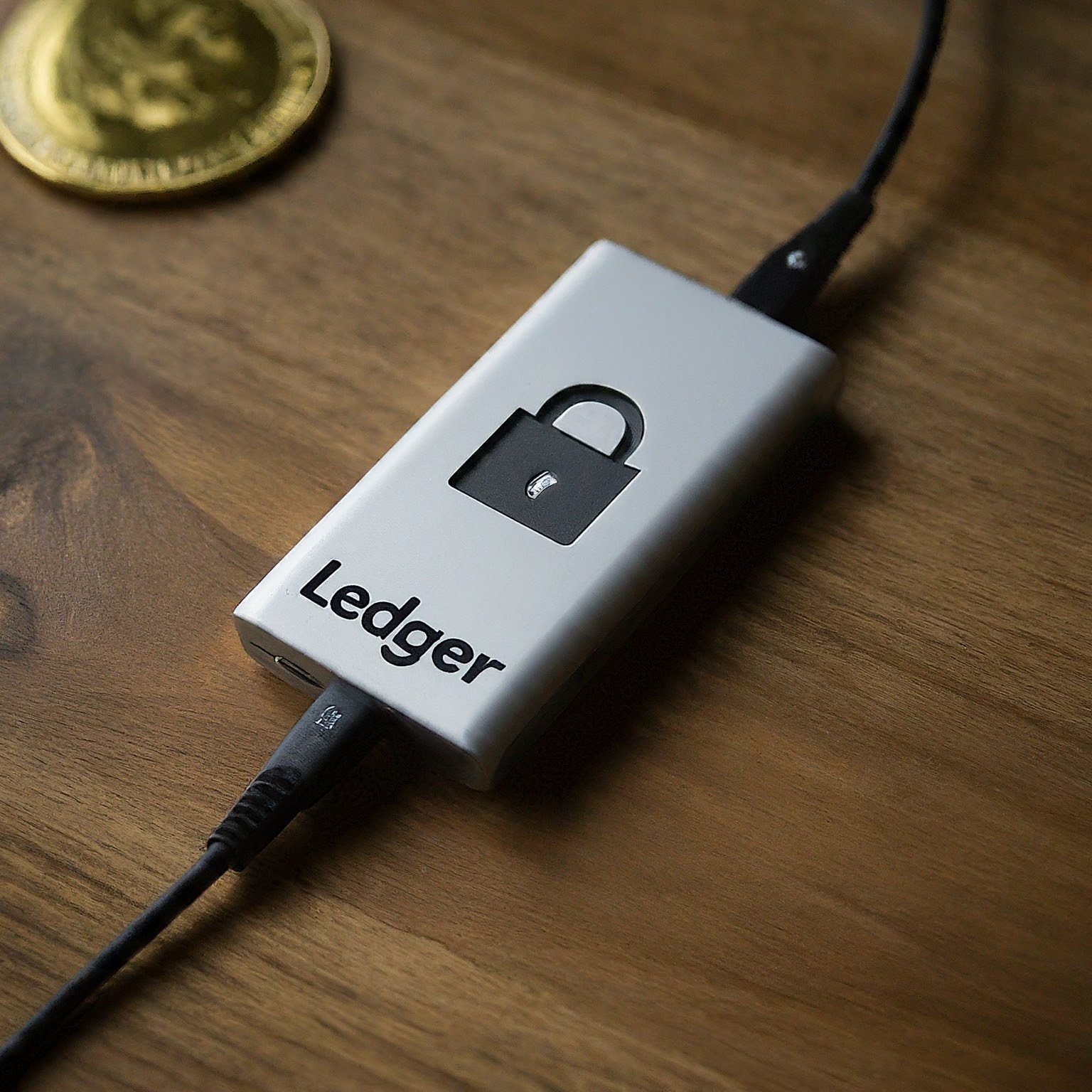Today, I’m going to be talking about and reviewing a key player in the cryptocurrency hardware wallet space which is the Ledger Nano S. Cryptocurrency is no small thing anymore. With more individuals hopping onto the crypto train, the focus on security is sharper than ever. That’s where hardware wallets come into the scene – offering that extra layer of security digital assets so desperately needs.
**UPDATE** – The original Ledger Nano S is no longer available on the Ledger site. They have what’s called the Ledger Nano S Plus as well as other Ledger wallets. If you want to see for yourself all the different types of cryptocurrency wallets they offer, you can do so by clicking here. (Here’s a little transparency: Our website contains affiliate links. This means if you click and make a purchase, we may receive a small commission. Don’t worry, there’s no extra cost to you. It’s a simple way you can support our mission to bring you quality content.)
Now what is a big publisher in the world of hardware wallets? Meet the Ledger Nano S. This neat little device is about securing your digital currency offline, away from the prying eyes of hackers and malware. It’s a tangible way to manage your virtual wealth, if you will.
I’m here to walk you through not just what the Ledger Nano S is, but why it has become a popular choice for cryptocurrency enthusiasts. It’s not just about keeping your digital coins under lock and key; it’s also about having peace of earth when it comes to your investments.
In a world where digital currency-related crime is on the rise, a reliable hardware wallet like the Ledger Nano S isn’t a luxury – it’s a necessity. This introduction aims to unpack the essentials of the Ledger Nano S, setting the stage for a deeper dive into getting it set up and running effectively.
Getting Started with Your Ledger Nano S

So you’ve taken the plunge and decided to secure your cryptocurrency holdings with a hardware wallet. Good move! Now, I’m going to help you through the process of getting your Ledger Nano S up and running.
First up, let’s talk about what comes in the box when you receive your Ledger Nano S. You’re going to find the device itself, a USB cable to connect to your computer, instructions, a keychain strap, and recovery sheets for writing down your backup passphrase.
The actual setup process is pretty straightforward, but it carries colossal significance. Start by connecting the device to your computer using the provided USB cable. Power it up, and you’ll be prompted to choose a PIN. This PIN is your first defense against unauthorized access, so choose something that’s not easily guessable but memorable to you.
Following this, the Ledger will generate a 24-word recovery phrase. Write this down on the provided recovery sheet and store it securely. This isn’t just about taking notes; it’s about safeguarding your entire cryptocurrency portfolio. If your device is ever lost or damaged, this phrase is the sole key to restoring your assets.
A piece of advice: Don’t worry too much about the technical jargon. Choose a secure PIN, write down your recovery phrase, and ensure your device’s firmware is updated via the Ledger Live app. These steps are crucial for a robust foundation of security.
Now, you’re probably eager to start sending and receiving cryptocurrency, but I encourage you to pause here. The next section, ‘Navigating the Ledger Nano S User Experience’, will dive into the Ledger Live software and how to manage your crypto assets effectively. This is where things get truly exciting, so stay tuned.
Navigating the Ledger Nano S User Experience
Now that you’ve got your Ledger Nano S set up, it’s time to get to know how to use it to the fullest. The user experience is integral to making your interactions smooth, and for newcomers, there’s a bit of a learning curve. Don’t worry too much about it though; I’m here to help you with that.
First off, you’re going to need to familiarize yourself with the Ledger Live interface. This is the software that you’ll use to manage your cryptocurrency assets. It’s where you can check your balances, send and receive crypto, and add new coins and tokens to your wallet. The interface is continually updated to ensure security patches and improved functionality, so make sure your software is up to date. 
Adding cryptocurrencies to your Ledger Nano S is straightforward. Start by installing the app for the specific cryptocurrency from the Ledger Live. Once the app is installed, you can add the account for the crypto you want to manage. The Ledger Nano S supports over 1,800 coins and tokens, so you’ll likely find your crypto of choice supported.
As for apps, think of your Ledger Nano S as a smartphone. You can install and uninstall apps depending on what cryptocurrencies you’re currently using. However, unlike a smartphone, the storage on the Ledger Nano S is quite limited, which means you may have to prioritize which apps are essential for you at any given time. My Ledger Nano S currently has three apps on it although it says it can support up to six. There are other, larger Ledger Nano wallets and I’ll talk about some of those in a future article.
Now with that being said, you might worry that you won’t have room to store any of your crypto. That is not the case. It is just the apps itself that take up room, the amount of cryptocurrency you have won’t take up any room. You could have hundreds of thousands of crypto and you would be just fine to store it, you just have to prioritze which crypto apps you want most on the Ledger Nano S.
Maximizing Your Ledger Nano S: Capacity and App Management
You might be wondering just how many apps you can store on your Ledger Nano S. Well, it’s crucial to know that your device is only equipped with a limited amount of storage space. And when it comes to managing that space, there’s a bit of strategy involved.
Each app on the Ledger Nano S takes up a certain amount of space, and because of the device’s hardware limitations, you can’t have every single cryptocurrency app installed at the same time. The good news is, Ledger has designed their system so that adding and removing apps is straightforward. Think of it as a wallet that you change out currencies in, depending on your needs for the day. 
Here’s a pro tip: you can use third-party tools to keep track of which apps you have installed previously to reinstall them quickly when needed. This can come handy in efficiently swapping out apps without having to remember your holdings off the top of your head.
The situation often leads us to prioritize which cryptocurrencies we want ready access to on our device. If you’re heavy into Bitcoin and Ethereum but only occasionally dabble in altcoins, it makes sense to keep the relevant apps for those mainstays installed and add in others as you transact with them.
Some users get creative with their app management, leveraging multiple Ledger devices or using one as a dedicated wallet for certain transactions or coins. Remember, your crypto assets are not stored in the apps themselves; they live on the blockchain and are accessed securely through the private keys stored on your Ledger device.
Lastly, I want to talk about updates. With the fast-paced changes in the cryptocurrency universe, apps get updates too. These updates can bring enhancements or support for more coins. It’s important to stay on top of these to ensure your Ledger Nano S apps give you the full benefit of their capabilities and security features.
Ensuring Ultimate Security with the Ledger Nano S
I’m going to walk you through why the Ledger Nano S isn’t just a storage device; it’s a vault for your digital assets. This device takes security to the next level, and I’m here to help you understand how.
Your Ledger Nano S operates with a robust security architecture. It’s designed to keep crypto assets secure from physical and virtual threats. That includes using a secure chip and a custom operating system designed specifically for protecting cryptocurrencies.
Don’t worry too much about the initial complexity of PINs, recovery phrases, and backup protocols. These features are your key to recovering your assets if your device is lost or stolen, and setting them up correctly is not as daunting as it might seem.
In my opinion, this wallet sets the bar for how cold storage should operate. You’re going to find out about true peace of mind with features like the auto-lock and the ability to store your recovery phrase offline securely.
Choose something that resonates with you beyond just functionality; trust plays a big role in managing your digital wealth. The Ledger Nano S provides various layers of security checks before any transaction gets confirmed.
There’s a lot of opportunity in the crypto space right now, and the Ledger Nano S helps you make the most of it securely. From everyday transactions to long-term holdings, your crypto journey is in safe hands with this device.
A lot can happen very quickly in the world of cryptocurrency. That’s why the Ledger Nano S is continually updated to address emerging threats and to ensure it remains an impenetrable fortress for your digital funds.
Remember, your first attempt at securing your crypto doesn’t need to be your last. Regularly updating your knowledge and the wallet’s firmware is an integral part of maintaining security.
If you are new to cryptocurrency, you might be wondering why you want to have a separate hard wallet for your cryptocurrency. Afterall, you purchased crypto off of a crypto exchange, so they should be secured on there right? Well, unfortunately, there are cases where some exchanges have been hacked and lost crypto, people have had their crypto assests frozen for various reasons, etc so it is not necesarrily a good thing to leave all your crypto on an exchange. This is why I have the Ledger Nano S although my version of it is a few years old.
I really hope that you feel empowered to take control of your crypto security with the Ledger Nano S. Thanks for joining me in exploring this remarkable device. Guard your digital wealth carefully, and the Ledger Nano S will be a trusty sidekick on your cryptocurrency adventure.

